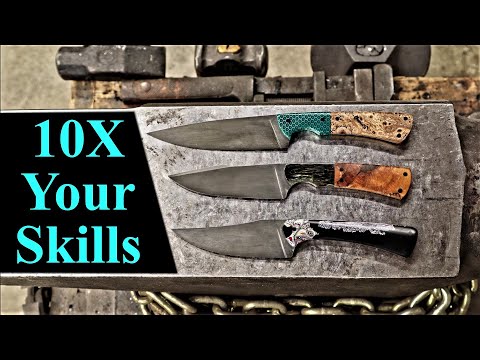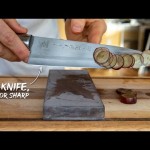
a9da15da29361843c0af671597faa93d
Sharpening a knife blade is an essential skill for any chef or home cook. It is important to keep your knives sharp and in good condition to ensure that they are safe and effective to use. Grinding a knife blade is a process that requires patience and precision, but with the right tools and techniques, it can be done with ease. In this article, we will provide a step-by-step guide on how to grind a knife blade, from selecting the right grinding wheel to honing the blade. With this guide, you will be able to sharpen your knife blades like a pro.
What grit for grinding knives
Grinding knives is a delicate process that requires the right tools and techniques to get the job done correctly. One of the most important aspects of grinding knives is choosing the right grit. Grit is the measure of the size of the abrasive particles used in the grinding process. The higher the grit, the finer the abrasive particles and the smoother the finish.
When it comes to grinding knives, the most common grits used are 120, 220, 400, and 600. A 120 grit is a coarse grit and is best used for removing large amounts of material quickly. It is also good for removing rust or other imperfections from the blade. A 220 grit is a medium grit and is best used for sharpening the blade. It is also good for removing small imperfections and polishing the blade.
A 400 grit is a fine grit and is best used for honing the blade. It is also good for polishing the blade and giving it a smooth finish. A 600 grit is an extra-fine grit and is best used for polishing the blade and giving it a mirror-like finish. It is also good for removing any remaining imperfections and giving the blade a professional look.
When choosing the right grit for grinding knives, it is important to consider the type of knife and the desired finish. For example, a kitchen knife may require a finer grit than a hunting knife. It is also important to consider the material of the blade. A softer material such as stainless steel may require a finer grit than a harder material such as carbon steel.
In conclusion, choosing the right grit for grinding knives is an important part of the process. The most common grits used are 120, 220, 400, and 600. The type of knife and the desired finish should be taken into consideration when selecting the right grit. With the right grit, you can achieve a professional finish on your knives.
What is the easiest knife grind
Knife grinding is an important part of knife making. It is the process of shaping and sharpening the blade of a knife. Different types of grinds can be used to create different types of knives, from kitchen knives to hunting knives. The easiest knife grind is the flat grind.
Flat grind is the simplest and most common type of grind. It is created by grinding both sides of the blade in a straight line from the spine to the edge. This creates a flat surface on both sides of the blade. This type of grind is easy to sharpen and maintain, and is suitable for most everyday tasks. It is also the most common type of grind used in kitchen knives.
The hollow grind is another popular type of grind. It is created by grinding the blade in a concave shape, creating a hollowed out area on both sides of the blade. This type of grind is very sharp, but it is also more difficult to sharpen and maintain. It is best suited for hunting and outdoor knives.
The convex grind is a more complex type of grind. It is created by grinding the blade in an outward curve, creating a convex surface on both sides of the blade. This type of grind is very strong and durable, and is suitable for heavy-duty tasks. It is also more difficult to sharpen and maintain.
No matter which type of grind you choose, it is important to understand the advantages and disadvantages of each. The flat grind is the easiest to sharpen and maintain, but it is not as strong or durable as other types of grinds. The hollow and convex grinds are more difficult to sharpen and maintain, but they are also stronger and more durable.
What kind of sander do I need for knife making
Knife making is a craft that requires precision and accuracy. To achieve the desired results, it is important to use the right tools. One of the most important tools for knife making is a sander. A sander is used to shape and smooth the blade of the knife, as well as to remove any burrs or imperfections. There are several different types of sanders available, and each one has its own advantages and disadvantages.
Belt Sanders are the most common type of sander used for knife making. They are powerful and can be used to quickly remove material from the blade. They are also relatively inexpensive and easy to use. However, they can be difficult to control and can leave behind scratches and gouges if not used properly.
Disc Sanders are another popular choice for knife making. They are more precise than belt sanders and can be used to create intricate shapes and patterns. They are also more expensive than belt sanders, but they are worth the investment if you are looking for a high-quality finish.
Random Orbital Sanders are a great choice for knife makers who want a smooth finish. They are easy to use and can be used to create a variety of shapes and patterns. They are also relatively inexpensive and can be used for a variety of other projects.
Hand Sanders are the most basic type of sander and are great for small projects. They are inexpensive and easy to use, but they are not as powerful as other types of sanders. They are best used for light sanding and finishing work.
When choosing a sander for knife making, it is important to consider your budget, the type of finish you are looking for, and the size of the project. Each type of sander has its own advantages and disadvantages, so it is important to do your research and choose the one that best suits your needs.
What are the different grinds on knife blades
Knives come in a variety of shapes and sizes, and the grind of the blade is an important factor in determining the knife’s performance. The grind of a knife blade refers to the shape of the cross-section of the blade. It is the profile that is created when the blade is ground down from its original shape. There are several different grinds that are commonly used on knife blades, each of which has its own advantages and disadvantages.
Flat Grind
The flat grind is the most basic and common grind used on knife blades. It is created by grinding both sides of the blade in a straight line from the spine to the edge. This grind is relatively easy to produce and is well-suited for general-purpose knives. It is also a good choice for knives that will be used for slicing and chopping.
Hollow Grind
The hollow grind is created by grinding the blade in a concave shape from the spine to the edge. This grind is very sharp and is well-suited for knives that will be used for slicing and cutting. However, it is not as strong as other grinds and can be prone to chipping or breaking if used for heavy-duty tasks.
Chisel Grind
The chisel grind is created by grinding one side of the blade in a straight line from the spine to the edge, while the other side is left unground. This grind is very sharp and is well-suited for knives that will be used for slicing and cutting. It is also a good choice for knives that will be used for carving and whittling.
Convex Grind
The convex grind is created by grinding the blade in a convex shape from the spine to the edge. This grind is very strong and is well-suited for knives that will be used for heavy-duty tasks such as chopping and splitting. It is also a good choice for knives that will be used for hunting and outdoor activities.
Scandinavian Grind
The Scandinavian grind is created by grinding the blade in a convex shape from the spine to the edge, with a secondary bevel on the edge. This grind is very sharp and is well-suited for knives that will be used for slicing and cutting. It is also a good choice for knives that will be used for carving and whittling.
Conclusion
The grind of a knife blade is an important factor in determining the knife’s performance. There are several different grinds that are commonly used on knife blades, each of which has its own advantages and disadvantages. It is important to choose the right grind for the job at hand in order to get the best performance from your knife.
We hope this guide has been helpful in teaching you how to grind a knife blade. Grinding a knife blade is a skill that takes time and practice to perfect, but with patience and dedication, you can become an expert. Goodbye and good luck!














